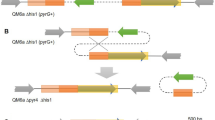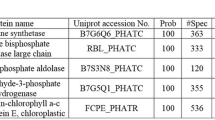Abstract
The histidine auxotroph mutant his1− isolated from Nicotiana plumbaginifolia haploid protoplasts was first characterized to be deficient for the enzyme histidinol phosphate aminotransferase that is responsible for one of the last steps of histidine biosynthesis. Expression of the mutated gene at the RNA level was assessed by northern analysis of various tissues. Transcriptional activity was unimpaired by the mutation and, in contrast, a higher level of expression was obtained when compared to the wild-type. The cDNA sequence encoding the mutated gene was isolated by RT-PCR and compared to the wild-type gene. A single point mutation corresponding to the substitution of a G nucleotide by A was identified at position 1212 starting from the translation site. The alignment of the deduced amino acid sequences from the mutated and wild-type gene showed that this mutation resulted in the substitution of an Arg by a His residue at position 381. This Arg residue is a conserved amino acid for histidinol phosphate aminotransferase of many species. These results indicate that the identified mutation results in an altered histidinol phosphate aminotransferase enzyme that is unable to convert the substrate imidazole acetol phosphate to histidinol phosphate and thereby leads to the blockage of histidine biosynthesis. Possible consequences of this blockage on the expression of other amino acid biosynthesis genes were evaluated by analysing the expression of the dhdps gene encoding dihydrodipicolinate synthase, the first key enzyme of the lysine pathway.
Similar content being viewed by others
References
Albani, D., Hammond-Kosack, MCU., Smith, C., Conlan, S., Colot, V., Holdsworth, M. and Bevan, M.W. 1997. The wheat. transcriptional activator SPA: a seed-specific bZIP protein that recognizes the GCN4-like motif in the bifactorial endosperm box of prolamin genes. Plant Cell 9: 171–184.
Bieleski, RL. and Turner, NA. 1966. Separation and estimation of amino acids in crude plant extracts by thin-layer electrophoresis and chromatography. Anal. Biochem. 17: 278–293.
Bourgin, JP., Chupeau, Y. and Misonier, C. 1979. Plant regeneration from mesophyll protoplasts of several Nicotiana species. Physiol. Plant. 45: 288–292.
Bradford, MM. 1976. A rapid and sensitive method for the quantitation of microgram quantities of protein utilizing the principle of protein-dye binding. Anal. Biochem. 72: 248–254.
Bright, S., Featherstone, L. and Milfin, B. 1979. Lysine metabolism in a barley mutant resistant to S(2-aminoethyl) cysteine. Planta 146: 629–633.
Brown, G. and Williamson, JM. 1987. Biosynthesis of folic acid, riboflavin, thiamine, and pantothenic acid. In: F.C. Neidhardt, J.L. Ingraham, K.B. Low, B. Magasanik, M. Schaechter and H.E. Umbarger (Eds.) Escherichia coli and Salmonella typhimurium: Cellular and Molecular Biology, vol. 1, American Society for Microbiology, Washington, D.C., pp. 521–538.
El Malki, F., Frankard, V. and Jacobs, M. 1998. Molecular cloning and expression of a cDNA sequence encoding histidinol phosphate aminotransferase from Nicotiana tabacum. Plant Mol. Biol. 37: 1013–1022.
Galili, G. 1995. Regulation of lysine and threonine synthesis. Plant Cell 7: 899–906.
Ghislain, M., Frankard, V., Vandenbossche, D., Matthews, B.F. and Jacobs, M. 1994. Molecular analysis of the aspatrate kinase-homoserine dehydrogenase gene from Arabidopsis thaliana. Plant Mol. Biol. 24: 835–851.
Guyer, D., Patton, D. and Ward, E. 1995. Evidence for cross-pathway regulation of metabolic gene expression in plants. Proc. Natl. Acad. Sci. USA 92: 4997–5000.
Hinnebusch, A.G. 1992. Transcriptional and translational regulation of gene expredssion in the general control of amino acid biosynthesis in Saccharomyces cerevisiae. Prog. Nucl. Acid Res. Mol. Biol. 38: 195–240.
Horsch, R.B. and King, J. 1983. Isolation of an isoleucine-valine-requiring auxotroph from Datura innoxia cell culture by arsenate counter selection. Planta 159: 12–17.
Fujimori, K. and Ohta, D. 1998a. Isolation and characterization of a histidine biosynthetic gene in Arabidopsis encoding a polypep-tide with two separate domains for phosphoribosyl-ATP py-rophosphohydrolase and phosphoribosyl-AMP cyclohydrolase. Plant Physiol. 118: 275–283.
Fujimori, K. and Ohta, D. 1998b. An Arabidopsis cDNA encoding a bifunctional glutamine amidotransferase/cyclase suppresses the histidine auxotrophy of a Saccharomyces cerevisiae his7 mutant. FEBS Lett. 428: 229–234.
Fujimori, K., Tada, S. and Ohta, D. 1998. Molecular cloning and characterization of the gene encoding N′-[(5′-phosphoribosyl)-formimino]-5-aminoimidazole-4-carboxamide ribonucleotide (BBM II) isomerase (EC 5.3.1.16) from Arabidopsis thaliana. Mol. Gen. Genet. 259: 216–223.
Maniatis, T., Tritsch, E.F. and Sambrook, J. 1982. Molecular Cloning: A Laboratory Manual, 2nd ed. Cold Spring Harbor Laboratory Press, Plainview, NY.
Martin, RG. 1963. The first enzyme in histidine biosynthesis: the nature of feedback inhibition by histidine. J. Biol. Chem. 238: 257–268.
Martin, R.G., Berberich, M.A., Ames, B.N., Davis, W.W., Gold-berger, R.F. and Yourno, J.D. 1971. Enzymes and intermediates at histidine biosynthesis in Salmonella typhimurium.Meth. Enzymol. 17 B: 3–44.
Mauri, I., Maddaloni, M., Lohmer, S., Motto, M., Salamini, F., Thompson, R. and Martegani, E. 1993. Functional expression of the transcription activator Opaque-2 of Zea mays in transformed yeast. Mol. Gen. Genet. 241: 319–326.
Mori, I., Fonné-Pfister, R., Matsunaga, S., Tada, S., Kimura, Y., Iwasaki, G., Mano, J., Hatano, M., Nakano, T., Koizumi, S., Scheidegger, A., Hayakawa, K. and Ohta, D. 1995. A novel class of herbicides. Plant Physiol. 107: 719–723.
Mourad, G. and King, J. 1995. L-O-Methylthreonine-resistant mu-tant of Arabidopsis defective in isoleucine feedback regulation. Plant Physiol. 107: 43–52.
Müller, M. and Knudsen, S. 1993. The nitrogen response of a barley C-hordein promoter is controlled by positive and negative regulation of the GCN4 and endosperm box. Plant J. 4: 343–355.
Nagai, A., Ward, E., Beck, J., Tada, S., Chang, J-Y., Scheidegger, A. and Ryals, J. 1991. Structural and functional conservation of histidinol dehydrogenase between plants and microbes. Proc. Natl. Acad. Sci. USA 88: 4133–4137.
Negrutiu, I., De Brouwer, D., Dirks, R. and Jacobs, M. 1985. Amino acid auxotrophs from protoplast cultures of N. plumbaginifolia Viviani. Mol. Gen. Genet. 199: 330–337.
Neuhard, J. and Nygaard, P. 1987. Purines and pyrimidines. In: F.C. Neidhardt, J.L. Ingraham, K.B. Low, B. Magasanik, M. Schaechter and H.E. Umbarger (Eds.) Escherichia coli and Salmonella typhimurium: Cellular and Molecular Biology, vol. 1, American Society for Microbiology, Washington, D.C., pp. 445–473.
Niyogi, K.K. and Fink, G.R. 1992. Two anthranilate sybthase genes in Arabidopsis: disease-related regulation of the tryptophan pathway. Plant Cell 4: 721–733.
Peterman, T.M. and Goodman, H.M. 1991. The glutamine synthetase gene family of Arabidopsis thaliana: light regulation and differential expression in leaves, root and seeds. Mol. Gen. Genet. 330: 145–154.
Pittard, A.J. 1987. Biosynthesis of the aromatic amino acids. In: F.C. Neidhardt, J.L. Ingraham, K.B. Low, B. Maagsanik, M. Schaechter and H.E. Umbarger (Eds.) Escherichia coli and Salmonella typhimurium: Cellular and Molecular Biology, vol. 1, American Society for Microbiology, Washington, D.C., pp. 368–394.
Ohta, D., Fujimori, K., Mizutani, M., Nakayama, Y., Kunpaisal-Hashimoto, R., Münzer, S. and Kozaki, A. 2000. Molecular cloning and characterization of ATP-phosphoribosyl transferase from Arabidopsis, a key enzyme in the histidine biosynthetic pathway. Plant Physiol. 122: 907–914.
Rerie, W.G., Whitecross, M. and Higgins, T.J.V. 1991. Developmental and environmental regulation of pea legumin genes in tobacco. Mol. Gen. Genet. 225: 148–157.
Singh, B.K. 1999. Plant Amino Acids: Biochemistry and Biotechnology. American Cyanamid Company, Princeton, NJ.
Tada, S., Hatano, M., Nakayama, Y., Volrath, S., Guyer, D., Ward, E., and Ohta, D. 1995. Insect cell expression of recombinant imidazole glycerol phosphate dehydratase of Arabidopsis and wheat and inhibition by triazole herbicides. Plant Physiol. 109: 153–159.
Tice-Baldwin, K., Fink, G.R. and Arndt, K.T. 1989. BAS1 has a Myb motif and activates HIS4 transcription only in combination with BAS2. Science 246: 931–935.
Umbarger, H.E. 1978. Amino acid biosynthesis. Annu. Rev. Biochem. 47: 533–606.
Winkler, M.E. 1987. Biosynthesis of histidine. In: F.C. Neid-hardt, J.L. Ingraham, K.B. Low, B. Magasanik, M. Schaechter and H.E. Umbarger (Eds.) Escherichia coli and Salmonella ty-phimurium: Cellular and Molecular Biology, American Society for Microbiology, Washington, D.C., pp: 399–411.
Zhao, J. and Last, R.L. 1996. Coordinate regulation of the tryptophan biosynthetic pathway and indolic phytoalexin accumulation in Arabidopsis. Plant Cell 8: 2235–2244.
Zhao, J., Williams, C.C. and Last, R.L. 1998. Induction of Arabidopsis tryptophan pathway enzymes and camalexin by amino acid starvation, oxidative stress, and an abiotic elicitor. Plant Cell 10: 359–370.
Author information
Authors and Affiliations
Rights and permissions
About this article
Cite this article
El Malki, F., Jacobs, M. Molecular characterization and expression study of a histidine auxotrophic mutant (his1−) of Nicotiana plumbaginifolia. Plant Mol Biol 45, 191–199 (2001). https://doi.org/10.1023/A:1006493021557
Issue Date:
DOI: https://doi.org/10.1023/A:1006493021557




